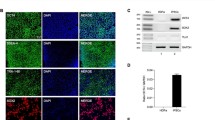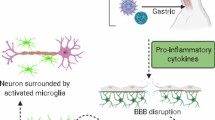Abstract
Japanese encephalitis (JE) is a viral encephalitis disease caused by Japanese encephalitis virus (JEV) infection. Uncontrolled inflammatory responses in the central nervous system (CNS) are a hallmark of severe JE. Although the CCR2–CCL2 axis is important for monocytes trafficking during JEV infection, little is known about its role in CNS trafficking of CD8+ T cells. Here, we characterized a mouse model of JEV infection, induced via intravenous injection (i.v.) and delineated the chemokines and infiltrating peripheral immune cells in the brains of infected mice. The CNS expression of chemokines, Ccl2, Ccl3, and Ccl5, and their receptors, Ccr2 or Ccr5, was significantly up-regulated after JEV infection and was associated with the degree of JE pathogenesis. Moreover, JEV infection resulted in the migration of a large number of CD8+ T cells into the CNS. In the brains of JEV-infected mice, infiltrating CD8+ T cells expressed CCR2 and CCR5 and were found to comprise mainly effector T cells (CD44+CD62L−). JEV infection dramatically enhanced the expression of programmed death 1 (PD-1) on infiltrating CD8+ T cells in the brain, as compared to that on peripheral CD8+ T cells in the spleen. This effect was more pronounced on infiltrating CCR2+CD8+ T cells than on CCR2−CD8+ T cells. In conclusion, we identified a new subset of CD8+ T cells (PD1+CCR2+CD8+ T cells) present in the CNS of mice during acute JEV infection. These CD8+ T cells might play a role in JE pathogenesis.




Similar content being viewed by others
References
Aleyas AG, George JA, Han YW, Rahman MM, Kim SJ, Han SB, Kim BS, Kim K, Eo SK (2009) Functional modulation of dendritic cells and macrophages by Japanese encephalitis virus through MyD88 adaptor molecule-dependent and -independent pathways. J Immunol 183:2462–2474
Bose S, Cho J (2013) Role of chemokine CCL2 and its receptor CCR2 in neurodegenerative diseases. Arch Pharm Res 36:1039–1050
Campbell GL, Hills SL, Fischer M, Jacobson JA, Hoke CH, Hombach JM, Marfin AA, Solomon T, Tsai TF, Tsu VD, Ginsburg AS (2011) Estimated global incidence of Japanese encephalitis: a systematic review. Bull World Health Organ 89(766–774):774A–774E
Cao S, Li Y, Ye J, Yang X, Chen L, Liu X, Chen H (2011) Japanese encephalitis Virus wild strain infection suppresses dendritic cells maturation and function, and causes the expansion of regulatory T cells. Virol J 8:39
Chen ST, Liu RS, Wu MF, Lin YL, Chen SY, Tan DT, Chou TY, Tsai IS, Li L, Hsieh SL (2012) CLEC5A regulates Japanese encephalitis virus-induced neuroinflammation and lethality. PLoS Pathog 8:e1002655
Chowdhury P, Khan SA (2018) Differential expression levels of inflammatory chemokines and TLRs in patients suffering from mild and severe Japanese encephalitis. Viral Immunol. https://doi.org/10.1089/vim.2018.0103
Das S, Ghosh D, Basu A (2009) Japanese encephalitis virus induce immuno-competency in neural stem/progenitor cells. PLoS ONE 4:e8134
Das S, Dutta K, Kumawat KL, Ghoshal A, Adhya D, Basu A (2011) Abrogated inflammatory response promotes neurogenesis in a murine model of Japanese encephalitis. PLoS ONE 6:e17225
Erlanger TE, Weiss S, Keiser J, Utzinger J, Wiedenmayer K (2009) Past, present, and future of Japanese encephalitis. Emerg Infect Dis 15:1–7
Getts DR, Terry RL, Getts MT, Muller M, Rana S, Shrestha B, Radford J, Van Rooijen N, Campbell IL, King NJ (2008) Ly6c+ “inflammatory monocytes” are microglial precursors recruited in a pathogenic manner in West Nile virus encephalitis. J Exp Med 205:2319–2337
Glass WG, Lim JK, Cholera R, Pletnev AG, Gao JL, Murphy PM (2005) Chemokine receptor CCR11 promotes leukocyte trafficking to the brain and survival in West Nile virus infection. J Exp Med 202:1087–1098
Gouwy M, Struyf S, Catusse J, Proost P, Van Damme J (2004) Synergy between proinflammatory ligands of G protein-coupled receptors in neutrophil activation and migration. J Leukoc Biol 76:185–194
Gupta N, Rao PV (2011) Transcriptomic profile of host response in Japanese encephalitis virus infection. Virol J 8:92
Han YW, Choi JY, Uyangaa E, Kim SB, Kim JH, Kim BS, Kim K, Eo SK (2014) Distinct dictation of Japanese encephalitis virus-induced neuroinflammation and lethality via triggering TLR3 and TLR4 signal pathways. PLoS Pathog 10:e1004319
Hosking MP, Lane TE (2010) The role of chemokines during viral infection of the CNS. PLoS Pathog 6:e1000937
Ireland DD, Tami C, Pedras-Vasconcelos J, Verthelyi D (2017) CD4 and CD8 T cells mediate distinct lethal meningoencephalitis in mice challenged with Tacaribe arenavirus. Cell Mol Immunol 14:90–107
Jain N, Oswal N, Chawla AS, Agrawal T, Biswas M, Vrati S, Rath S, George A, Bal V, Medigeshi GR (2017) CD8 T cells protect adult naive mice from JEV-induced morbidity via lytic function. PLoS Negl Trop Dis 11:e0005329
Jin HT, Anderson AC, Tan WG, West EE, Ha SJ, Araki K, Freeman GJ, Kuchroo VK, Ahmed R (2010) Cooperation of Tim-3 and PD-1 in CD8 T-cell exhaustion during chronic viral infection. Proc Natl Acad Sci U S A 107:14733–14738
Kaushik DK, Gupta M, Kumawat KL, Basu A (2012) NLRP3 inflammasome: key mediator of neuroinflammation in murine Japanese encephalitis. PLoS ONE 7:e32270
Kim HJ, Verbinnen B, Tang X, Lu L, Cantor H (2010) Inhibition of follicular T-helper cells by CD8(+) regulatory T cells is essential for self tolerance. Nature 467:328–332
Kim JH, Patil AM, Choi JY, Kim SB, Uyangaa E, Hossain FM, Park SY, Lee JH, Kim K, Eo SK (2016) CCL2, but not its receptor, is essential to restrict immune privileged central nervous system-invasion of Japanese encephalitis virus via regulating accumulation of CD11b(+) Ly-6C(hi) monocytes. Immunology 149:186–203
Lannes N, Neuhaus V, Scolari B, Kharoubi-Hess S, Walch M, Summerfield A, Filgueira L (2017) Interactions of human microglia cells with Japanese encephalitis virus. Virol J 14:8
Larena M, Regner M, Lobigs M (2012) The chemokine receptor CCR23, a therapeutic target for HIV/AIDS antagonists, is critical for recovery in a mouse model of Japanese encephalitis. PLoS ONE 7:e44834
Li F, Wang Y, Yu L, Cao S, Wang K, Yuan J, Wang C, Wang K, Cui M, Fu ZF (2015) viral infection of the central nervous system and neuroinflammation precede blood–brain barrier disruption during Japanese encephalitis virus infection. J Virol 89:5602–5614
Lim JK, Obara CJ, Rivollier A, Pletnev AG, Kelsall BL, Murphy PM (2011) Chemokine receptor Ccr2 is critical for monocyte accumulation and survival in West Nile virus encephalitis. J Immunol 186:471–478
Lv BM, Tong XY, Quan Y, Liu MY, Zhang QY, Song YF, Zhang HY (2018) Drug repurposing for Japanese encephalitis virus infection by systems biology methods. Molecules. https://doi.org/10.3390/molecules23123346
Michlmayr D, Lim JK (2014) Chemokine receptors as important regulators of pathogenesis during arboviral encephalitis. Front Cell Neurosci 8:264
Nansen A, Marker O, Bartholdy C, Thomsen AR (2000) CCR28+ and CCR28+CD8+ T cells increase during viral infection and migrate to sites of infection. Eur J Immunol 30:1797–1806
Ransohoff RM, Engelhardt B (2012) The anatomical and cellular basis of immune surveillance in the central nervous system. Nat Rev Immunol 12:623–635
Sharpe AH, Wherry EJ, Ahmed R, Freeman GJ (2007) The function of programmed cell death 1 and its ligands in regulating autoimmunity and infection. Nat Immunol 8:239–245
Singh A, Kulshreshtha R, Mathur A (2000) Secretion of the chemokine interleukin-8 during Japanese encephalitis virus infection. J Med Microbiol 49:607–612
Solomon T, Dung NM, Kneen R, Gainsborough M, Vaughn DW, Khanh VT (2000) Japanese encephalitis. J Neurol Neurosurg Psychiatry 68:405–415
Tiwari S, Singh RK, Tiwari R, Dhole TN (2012) Japanese encephalitis: a review of the Indian perspective. Braz J Infect Dis 16:564–573
Wang H, Liang G (2015) Epidemiology of Japanese encephalitis: past, present, and future prospects. Ther Clin Risk Manag 11:435–448
Winter PM, Dung NM, Loan HT, Kneen R, Wills B, le Thu T, House D, White NJ, Farrar JJ, Hart CA, Solomon T (2004) Proinflammatory cytokines and chemokines in humans with Japanese encephalitis. J Infect Dis 190:1618–1626
Yang Y, Ye J, Yang X, Jiang R, Chen H, Cao S (2011) Japanese encephalitis virus infection induces changes of mRNA profile of mouse spleen and brain. Virol J 8:80
Yurchenko E, Tritt M, Hay V, Shevach EM, Belkaid Y, Piccirillo CA (2006) CCR37-dependent homing of naturally occurring CD4+ regulatory T cells to sites of Leishmania major infection favors pathogen persistence. J Exp Med 203:2451–2460
Zelinskyy G, Myers L, Dietze KK, Gibbert K, Roggendorf M, Liu J, Lu M, Kraft AR, Teichgraber V, Hasenkrug KJ, Dittmer U (2011) Virus-specific CD8+ T cells upregulate programmed death-1 expression during acute friend retrovirus infection but are highly cytotoxic and control virus replication. J Immunol 187:3730–3737
Acknowledgements
This work was supported by grants from the Key Research and Development Program of the Ministry of Science and Technology of China (2016YFD500407), Precision Medicine program of Ministry of Science and Technology of China (2016YFC0905902), and the National Natural Science Foundation of China (81630043, 81571552). We thank the Core Facility and Technical Support in the Wuhan Investigate of Virology. We are grateful to Ding Gao and Juan Min for technical support for flow cytometry and mass cytometry, as well as Xuefang An and Fan Zhang for valuable assistance in the animal studies.
Author information
Authors and Affiliations
Contributions
BW and JY conceptualized and designed the study. LLQ, TL and FZ performed the experiments in this study, and analyzed the data. SBC and JY contributed virus strain and virus infection techniques to this study. DY and XJL participated in part of experimental work. FZ wrote the manuscript. All authors read and approved the final manuscript.
Corresponding authors
Ethics declarations
Conflict of interest
The authors declare that they have no conflict of interest.
Animal and Human Rights Statement
The study was approved by the Animal Ethics Committee of Wuhan Institute of Virology. All institutional and national guidelines for the care and use of laboratory animals were followed.
Electronic supplementary material
Below is the link to the electronic supplementary material.
Rights and permissions
About this article
Cite this article
Zhang, F., Qi, L., Li, T. et al. PD1+CCR2+CD8+ T Cells Infiltrate the Central Nervous System during Acute Japanese Encephalitis Virus Infection. Virol. Sin. 34, 538–548 (2019). https://doi.org/10.1007/s12250-019-00134-z
Received:
Accepted:
Published:
Issue Date:
DOI: https://doi.org/10.1007/s12250-019-00134-z




